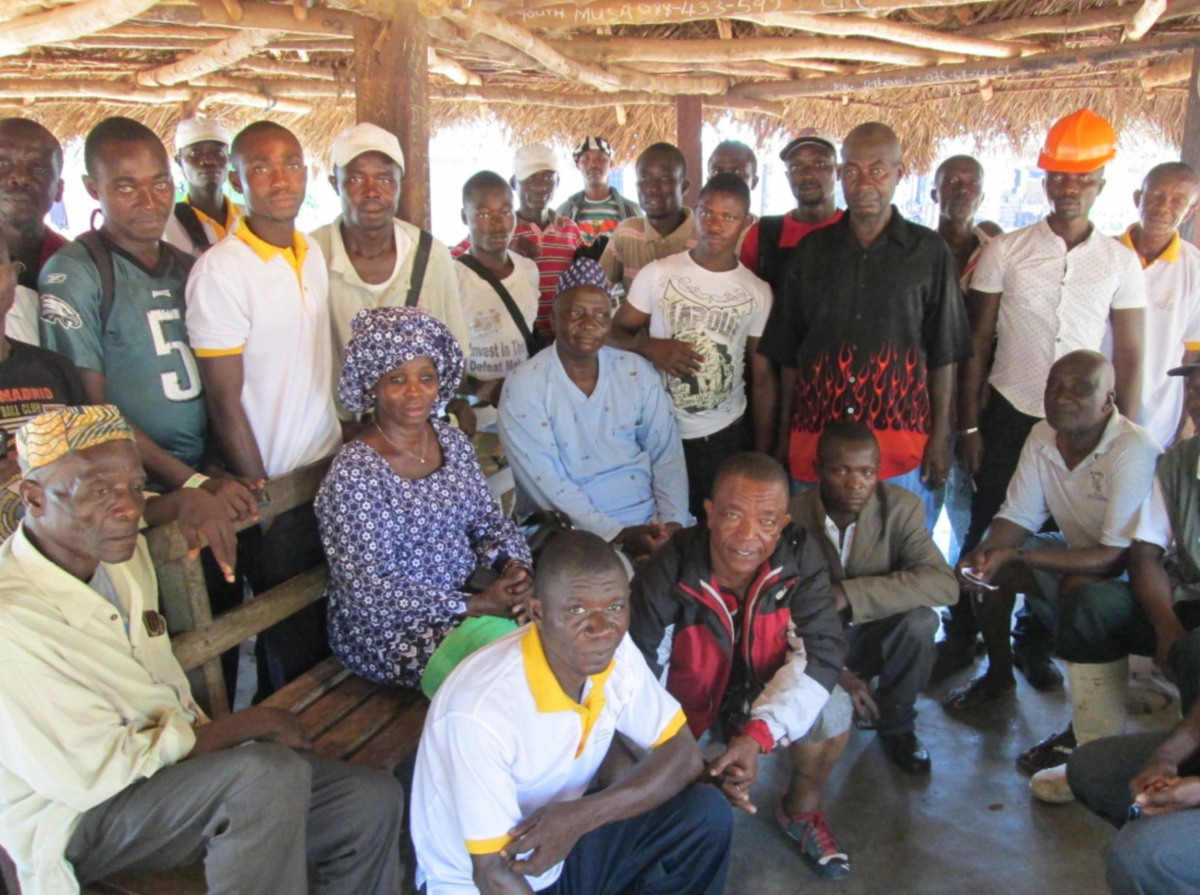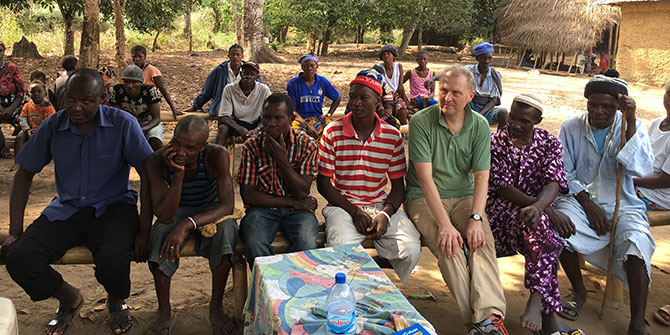The response to the 2014–15 Ebola outbreak in Sierra Leone is the subject of much debate, but the role played by chiefs in containing its spread is often overlooked. Paul Richards explores the benefits that chiefs in Sierra Leone had over politicians and medical experts in handling the crisis, and the questions this raises for public authority in the face of future outbreaks.
This article is part of the Public Authority blog series with LSE’s Centre for Public Authority and International Development. See all posts from the series addressing the Ebola outbreak here.
The bottom level of government in provincial Sierra Leone is the chiefdom. Each chiefdom administration is led by a Paramount Chief, who presides over a council. Chiefdoms were delimited under British colonialism, but from a pre-existing jigsaw of micro-polities dotted across forest landscape.
In this pre-colonial world chiefs were generally selected by elders on merit; they wanted a leader to defend the community against various challenges. Warriors predominated, but in the later 19th century, knowledge of the world of trade and markets also proved desirable. A number of women were elected as paramount chiefs.
Under a system of local government originally devised under British colonial rule, a prime responsibility of the paramount chief was to spot trouble, solve it where he or she could, or to call in help from higher authorities. This included keeping an eye open for threatening events, such as hunger or disease.
Sierra Leone was badly affected by an epidemic of Ebola Virus Disease in 2014–15. There were 8,000–13,000 cases, and over 4,000 people died. Controlling Ebola raised some pressing questions concerning public authority.
Ebola is a social disease, in the sense that it infects those who care for the sick.
Early in the epidemic, there was a large hospital outbreak in Kenema, affecting nurses in particular. Thereafter, hospital and medical centres were shunned. Relatives and in-laws attempted to cope with the disease at home, and case numbers surged. Controlling the epidemic required families to understand the disease and seek help.
But governments are not very good at telling families what to do. In Sierra Leone, as elsewhere, some things are private. Caring for the sick and burying the dead (both major pathways for infection) belong to this private sphere. Its procedures are not the business of officials.
To the shock of many, the government of Sierra Leone, faced with the threat of Ebola, began to issue detailed instructions about how burials were to be conducted.
In fact, under the government’s hastily-enacted Ebola rules, families were not supposed to be involved in burials at all. Burial had to be handled by a specially-trained team clad in hazmat gear. The rule applied to all burials, since it was not possible without further laboratory investigation to tell which persons had died of the disease. Burial cannot wait days for laboratory tests to be completed.
This invasion of family burial by the state provoked a storm of protest, and a stand-off resulted. How was it to be addressed?
One badly needed change was to allow pastors and imams to pray for the dead at the graveside, while the family witnessed from a distance. This alone, however, was not enough to halt infection cases, because it was not the funerals themselves that caused the disease but family care for the sick, and the washing of corpses to prepare the body for burial. Families had to be persuaded to report cases quickly, and to call in burial teams to take charge of the body. Interlocutors for this sensitive task were surprisingly close to hand.
Paramount Chiefs had long been rather neglected as potential promoters of family health, even though they had responsibility for sanitation at the local level. The war had displaced many chiefs, and although the British government had responded to a request to restore them to their chiefdoms after the war, their post-war role had been shaped more by security than health promotion considerations.
In Ebola, however, they came into their own, since the disease was both a health challenge and a security concern. They had one major advantage over all other officials. They lived with their people and knew intimately local social conditions. In disputes over land, marriage or inheritance the chief was often a first port-of-call.
When Ebola regulations prevented villagers from visiting a sick family member, chiefs understood the local frustration. They also shared in the sense of desolation when Ebola burial teams in hazmat suits armed with long poles to dump the corpse in the grave ran burial services. After bush meat was banned, for fear that Ebola was spread by forest animals, chiefs felt its absence from their own plate.
In short, chiefs understood the plight of the average villager. For that reason their advice on Ebola was often trusted.
Not all chiefs facilitated the ending of infections. Some so sympathised with their people that they connived at breaches of Ebola sanitation rules. Others were ineffective because they were already at odds with their people.
In a majority of cases, however, chiefs could explain the risks of the disease in a way that was believable to even the most sceptical of villagers. Recent research suggests that chiefdom vigilance and leadership was often a crucial factor in halting infection chains.
The capacity for chiefs to lead the Ebola response was first apparent in Kailahun, the first district to experience the disease, where the most badly affected chiefdom, Jawei, had all but ended its outbreak by the end of July 2014 under the leadership of the Paramount Chief, well before the major international response arrived in-country.
The chosen tool of chiefs in Kailahun was to draft a set of local bye-laws restricting movement, requiring case reporting and imposing ‘safe burial’. These rules were implemented by volunteers mobilised as chiefdom Ebola task-forces, on lines not dissimilar to the ‘hunter militias’ that had helped stem the tide of war two decades earlier. These task forces were sufficiently effective for the model to be adopted nationally in August 2014.
It is not only in chiefdoms where there were large outbreaks that beneficial interventions by chiefs can be traced. Other instances where the influence of strong leadership can also be seen are in those chiefdoms where infection was kept to zero. There were 39 such chiefdoms (out of 149).
One chiefdom in the centre of the country with no cases, but surrounded by outbreaks on all sides, has been a specific focus for research attention. Here, keeping cases to zero was no accident. The young chief was proactive in closing his chiefdom to visitors, even going so far as to build a small holding centre for any patients turning up with high fevers, to prevent their admission to the village health centre before Ebola had been ruled out by blood tests.
A third recently-documented instance, however, shows the limits of chieftaincy, in cases where public authority is contested.
In this specific instance, it turned out that defiance of Ebola rules was rooted in a long-running dispute about the legitimacy of one of the local sub-chiefs. Villagers were unwilling to report infections to the authorities because to do so would have required them to pass information through a centre of local power they held to be illegitimate. A spike of cases resulted. These were treated at home, with mixed results, and the dead were buried by night in secret graves.
It would appear that a key lesson of the Ebola epidemic in Sierra Leone, therefore, is that infection was better controlled where there was good rapport between the people and the chiefdom authorities. For all their faults as democrats, paramount chiefs were locally more believable than politicians or medical experts in addressing the disease as a ‘family problem’. The restoration of paramount chiefs caused controversy after the civil war because they were seen by many as a relic of a pre-democratic era, but their ability to exercise public authority, blended with family concern, proved invaluable in controlling a terrifying disease.








All that a chief can do, an elected local ward Councillor can also do, if given the required resources – do you agree?